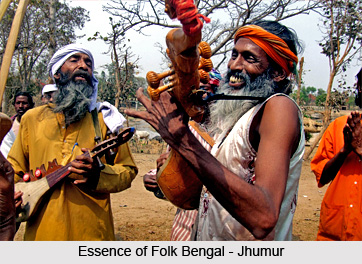 Jhumur music is a very dubious term. To find the etymology it is not unnatural for writers and scholars to connect it with Jhombada-Prabandha as mentioned in Sangit-Ratnakar of the 13th century. One of the main terms of the techniques of Padavali Kirtan was set up by the end of the 16th century was Jhumur, which is in vogue even today with other terms like Ankharfakhar, Tuk, Chuta and so on. But in folk-songs the first type of Jhumur relates to the song propagated by the Santals tribe. Songs are of hybrid type. These people of Austric group lived with the people of the western sector of Indian state of West Bengal from pre-historical times. The exchange of culture resulted in a peculiarly blended musical form as explained by the term Jhumur. The Santal tune and its rhythm played on madal were later transformed into folk-music.
Jhumur music is a very dubious term. To find the etymology it is not unnatural for writers and scholars to connect it with Jhombada-Prabandha as mentioned in Sangit-Ratnakar of the 13th century. One of the main terms of the techniques of Padavali Kirtan was set up by the end of the 16th century was Jhumur, which is in vogue even today with other terms like Ankharfakhar, Tuk, Chuta and so on. But in folk-songs the first type of Jhumur relates to the song propagated by the Santals tribe. Songs are of hybrid type. These people of Austric group lived with the people of the western sector of Indian state of West Bengal from pre-historical times. The exchange of culture resulted in a peculiarly blended musical form as explained by the term Jhumur. The Santal tune and its rhythm played on madal were later transformed into folk-music.
It is often observed that while songs on marriage rites and other festivals are composed on the Santali dialect, love songs are composed in mixed Bengali language with adequate local phonetic colour. Themes of love songs do not contain Radha-Lord Krishna or Lord Rama-Sita episodes. These are simple naturalistic expressions of life, often called majhi gan. Themes abound with reports of everyday affairs - food, refreshment, hair decoration, tobacco smoking, hankering after child birth (son), flower, bird, visit to a marriage ceremony at Tatanagar, etc. The nature of compositions is more or less descriptive, direct and condensed in a few lines like some sort of ditty. The particular character of music is first revealed by the accompaniment of madal, displaying mono-rhythmic divisions of three beats.
Spontaneity of musical form, words, repetition, loudness and rhythmic swing are typically contained in this type of Jhumur Music of this type along with its elements of dance has been transformed into: (1) Dandsalia, (2) Khemti, (3) Patanac, (4) Bhadaria, (5) Rang and (6) Karam which are mostly sung to the accompaniment of madal and dhamsa. The language is of a hybrid type. The principal characters are Radha, Ravana, Nanadi (the husband`s sister), and all these contents are produced in a hybrid local dialect. The Nacni Jhumur is virtually a performance by professional Khemti women. The music was not popular even a few decades back. Patanac is connected with Karam festival of a group of Mundari society. Bhadariya Jhumur, performed mostly by women, is a typical dance song of Purulia district, sung in the month of Bhadra. Description of nature blended with problems of womenfolk occurs in these songs like those of Karam songs.
Karam worship is an imbibed programme of the agricultural Hindu community of Purulia district and Bankura district borrowed from the Santals. The period of performance is the rainy after-month of Bhadra (eleventh day of full moon), when Bhadu remains also in swing. A branch of Karam tree planted in an open space is considered as the Karam deity around that dance and music are arranged. Madal is the main instruments used for accompaniment.




















